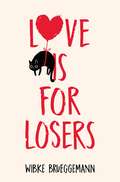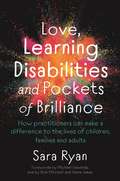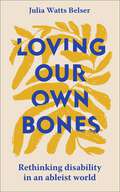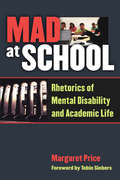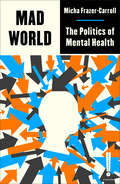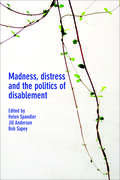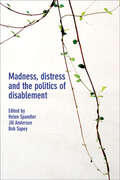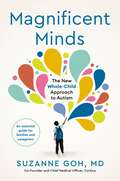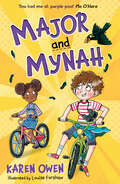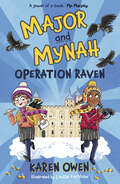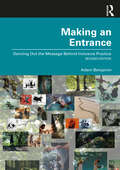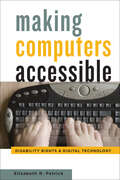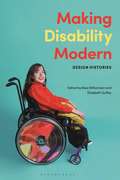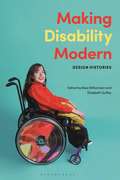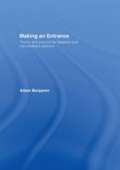- Table View
- List View
Love is for Losers (Phoebe Davis Thinks . . . #1)
by Wibke BrueggemannA laugh out loud look at first love, loss and trying to avoid the girl of your dreams.What a stupid expression that is in the first place: To fall in love.Like you fall into a ditch or something.Maybe people need to look where they’re going.As far as Phoebe Davis is concerned, love is to be avoided at all costs. Why would you spend your life worrying about something that turns you into a complete moron? If her best friend Polly is anything to go by, the first sniff of a relationship makes you forget about your friends (like, hello?), get completely obsessed with sex (yawn) and bang on constantly about a person who definitely isn't as great as you think they are. So Phoebe isn't going to fall in love, ever. But then she meets Emma . . . Love is for Losers by Wibke Brueggemann is a hilarious, life-affirming novel about all the big stuff: love, sex, death, family, heartbreak, kittens . . . and kisses that turn the whole world upside down.
Love, Learning Disabilities and Pockets of Brilliance: How Practitioners Can Make a Difference to the Lives of Children, Families and Adults
by Sara RyanFind some pockets of brilliance for your practice! Insights and inspiration from families of learning disabled people, who share their lives, challenges and wishes. Discover what sorts of help will really help the people you support.
Loving Our Own Bones: Rethinking disability in an ableist world
by Julia Watts BelserOpen the Bible, and disability is everywhere. Moses stutters and thinks himself unable to answer God's call. Isaac's blindness lets his wife trick him into bestowing his blessing on his younger son. Jesus heals the sick the blind, the paralyzed, and the possessed. For centuries, these stories have been told and retold by commentators who treat disability as misfortune, as a metaphor for spiritual incapacity, or as a challenge to be overcome.Loving Our Own Bones turns that perspective on its head. Drawing insights from the hard-won wisdom of disabled folks who've forged difference into fierce and luminous cultural dissent, Belser offers fresh and unexpected readings of familiar biblical stories, showing how disability wisdom can guide us all toward a powerful reckoning with the complexities of the flesh. She talks back to biblical commentators who traffic in disability stigma and shame, challenging interpretations that demean disabled people and diminish the vitality of disabled lives. And she shows how Sabbath rest can be a powerful counter to the relentless demand for productivity, an act of spiritual resistance in a culture that makes work the signal measure of our worth.With both a lyrical love of tradition and incisive political analysis, Belser braids spiritual perspectives together with keen activist insights-inviting readers to claim the power and promise of spiritual dissent, to nourish their own souls through the revolutionary art of radical self-love.
Low-Demand Parenting: Dropping Demands, Restoring Calm, and Finding Connection with your Uniquely Wired Child
by Amanda Diekman"Low-demand parenting requires radical acceptance. It says to the kid right in front of you, I see you, just as you are. - You are ok here. I love you right here."Parent to neurodivergent children and autistic adult, Amanda Diekman, outlines a parenting approach that finally lowers the bar for the whole family, enabling the equilibrium of the home to be restored.Low-demand parenting allows you to drop the demands and expectations that are making family life impossible and embrace the joyful freedom of living life with low demands. It can be a particularly effective approach for children with high anxiety levels including neurodivergent children. Amanda talks from experience and teaches you how to identify what the big, tiny and invisible demands are for your own child and gives you the step-by-step instructions on how to drop them.Full of practical resources and scripts that are easy to implement in busy everyday life, this book is your flashlight and your map to parenting your uniquely wired child. It will not tell you where to go, but it will help you find your way so you and your family thrive.
Lucky
by null Ed Jackson‘What a story and what an inspirational human. Ed is a total legend.’ Joe Wicks ‘A life-affirming story . . . inspirational’ Tim Peake As seen in the Daily Mail From tragedy to triumph, one step at a time – an inspirational story of triumph over adversity against the odds At just 28 years old, Ed Jackson was told he would never walk again. After a miscalculated dive into a pool, he suffered multiple cardiac arrests, a broken neck and a partially severed spinal cord. Lying paralysed in intensive care, the former rugby player knew his life would never be the same. But he wasn’t ready to give up hope. Driven by relentless determination, Ed embarked on an incredible journey to independence. Millimetre by millimetre, he began to regain movement in his fingers and toes. Defying the expectations of even the most optimistic doctors, step by step, Ed began to walk again. Fuelled by a renewed appreciation for life and a determination to help others suffering similar injuries to his own, Ed set his sights on a new challenge: mountaineering. Embarking on a gruelling climb to raise funds for a spinal unit in Kathmandu, Ed realises that, once again, the odds are stacked against him. Will he be able to overcome his own life-changing injury and transform others’ lives for the better? Lucky is the story of how Ed faced the impossible when it seemed all hope was lost, and shows how you, too, can overcome the biggest challenges that life sends your way. Lucky was a Sunday Times bestseller in the w/b August 9th 2021
M in the Middle: Secret Crushes, Mega-Colossal Anxiety and the People's Republic of Autism
by Vicky Martin The Students of Limpsfield Grange SchoolFrom the authors of M is for Autism, this YA novel follows M after her autism diagnosis. Faced with an exciting crush, a pushy friend and an unhelpful Headteacher, how long until the beast of anxiety pounces again?
M is for Autism
by Vicky Martin The Students of Limpsfield Grange SchoolWritten by the students of Limpsfield Grange School for girls with autism, M is for Autism is a truly authentic coming-of-age novel that shows what it's really like to grow up feeling a bit different. Why is being normal so easy for everyone else? Will finally getting a label help M to make sense of it all? What does normal even mean anyway?
Mad at School: Rhetorics of Mental Disability and Academic Life (Corporealities: Discourses Of Disability)
by Margaret Price"A very important study that will appeal to a disability studies audience as well as scholars in social movements, social justice, critical pedagogy, literacy education, professional development for disability and learning specialists in access centers and student counseling centers, as well as the broader domains of sociology and education." ---Melanie Panitch, Ryerson University "Ableism is alive and well in higher education. We do not know how to abandon the myth of the 'pure (ivory) tower that props up and is propped up by ableist ideology.' . . . Mad at School is thoroughly researched and pathbreaking. . . . The author's presentation of her own experience with mental illness is woven throughout the text with candor and eloquence." ---Linda Ware, State University of New York at Geneseo Mad at School explores the contested boundaries between disability, illness, and mental illness in the setting of U.S. higher education. Much of the research and teaching within disability studies assumes a disabled body but a rational and energetic (an "agile") mind. In Mad at School, scholar and disabilities activist Margaret Price asks: How might our education practices change if we understood disability to incorporate the disabled mind? Mental disability (more often called "mental illness") is a topic of fast-growing interest in all spheres of American culture, including popular, governmental, aesthetic, and academic. Mad at School is a close study of the ways that mental disabilities impact academic culture. Investigating spaces including classrooms, faculty meeting rooms, and job searches, Price challenges her readers to reconsider long-held values of academic life, including productivity, participation, security, and independence. Ultimately, she argues that academic discourse both produces and is produced by a tacitly privileged "able mind," and that U.S. higher education would benefit from practices that create a more accessible academic world. Mad at School is the first book to use a disability-studies perspective to focus on the ways that mental disabilities impact academic culture at institutions of higher education. Individual chapters examine the language used to denote mental disability; the role of "participation" and "presence" in student learning; the role of "collegiality" in faculty work; the controversy over "security" and free speech that has arisen in the wake of recent school shootings; and the marginalized status of independent scholars with mental disabilities. Margaret Price is Associate Professor of English at Spelman College.
Mad World: The Politics of Mental Health (Outspoken by Pluto)
by Micha Frazer-CarrollMental health affects us all, and yet it remains elusive as a concept. Does getting a diagnosis help or hinder? How is mental wellbeing, which is often incredibly personal, driven by widespread societal suffering? Can it be a social construct and real at the same time? These are some of the big questions Micha Frazer-Carroll asks as she reveals mental health to be a political issue that needs deeper understanding beyond today’s 'awareness raising' campaigns. Exploring the history of asylums and psychiatry; the relationship between disability and broader liberation movements; alternative models of care; the relationship between art and mental health; law and the decarceration of mental health, Mad World is a radical and hopeful antidote to pathologisation, gatekeeping and the policing of imagination.
Madness, distress and the politics of disablement
by Helen Spandler Jill AndersonThis book explores the challenges of applying disability theory and policy, including the social model of disability, to madness and distress. It brings together leading scholars and activists from Europe, North America, Australia and India, to explore the relationship between madness, distress and disability. Whether mental health problems should be viewed as disabilities is a pressing concern, especially since the inclusion of psychosocial disability in the UN Convention on the Rights of Persons with Disabilities. This book will appeal to policy makers, practitioners, activists and academics.
Madness, distress and the politics of disablement
by Helen Spandler Jill AndersonThis book explores the challenges of applying disability theory and policy, including the social model of disability, to madness and distress. It brings together leading scholars and activists from Europe, North America, Australia and India, to explore the relationship between madness, distress and disability. Whether mental health problems should be viewed as disabilities is a pressing concern, especially since the inclusion of psychosocial disability in the UN Convention on the Rights of Persons with Disabilities. This book will appeal to policy makers, practitioners, activists and academics.
Magnificent Minds: The New Whole-Child Approach to Autism
by Dr Suzanne Goh“For years, I searched for a book that I could recommend to parents—those just beginning to learn about autism as well as those with decades of experience. I looked for a book with all the essential information—the liquid gold—something a busy parent could get through while keeping up with the demands of life. I couldn’t find that book, so I decided to write it.”Dr Suzanne Goh is a renowned paediatric neurologist who has spent decades working with autistic children. In this ground-breaking book, Goh combines her extensive experience with original research to give you a clear understanding of what autism is and how to create a holistic treatment roadmap for your child.Based on Goh’s revolutionary ‘whole child approach,’ you’ll discover how to:- Best support every aspect of your child’s health- Get the help you need and build a strong and supportive team- Make informed decisions based on a deep understanding of your child’s brain and bodyMost importantly, Magnificent Minds will show you how to recognise and nurture your child’s innate strengths – their intelligence, abilities, and gifts – and celebrate their neurodiverse magnificence.
Major and Mynah
by Karen OwenJoin SPUD, the Super Perceptive Undercover Detectives, on their first fast-paced detective adventure.Getting your first hearing aids can be nerve-wracking; especially when you have to wear them to school. When Callie realises her new hearing aids - 'the Slugs' - give her the unique ability to communicate with Bo the Mynah bird, some of her worries are lifted. In fact, having a pair of eyes in the sky might come in handy...The duo team up with Callie's best friend, Grace, as they set out to catch a local thief who has been causing trouble all over town. Includes high-speed chases, a very peckish bird and purple POO!A new mystery series, illustrated by Louise Forshaw and perfect for reluctant readers.
Major and Mynah: Operation Raven (Major and Mynah #2)
by Karen OwenWhen Bo sneaks into Callie’s bag on her school trip to the Tower of London, she and Grace make plans to keep him secret. But when some gold coins and jewels are stolen from the site, having a spy in the sky comes in useful! The second hilarous instalment in the Major and Mynah series.
Make Your Own Picture Stories for Kids with ASD (Autism Spectrum Disorder): A DIY Guide for Parents and Carers
by Brian AttwoodEver wanted to create a picture story to help your ASD kid get through a difficult situation, but let your lack of artistic skills hold you back? That won't be a problem anymore, with this step-by-step guide to creating simple picture stories that can be adapted for absolutely any situation, whether at home, in the classroom, or on-the-go.
Making an Entrance: Dancing Out the Message Behind Inclusive Practice
by Adam BenjaminThis second edition of Making an Entrance is a practical and thought-provoking introduction to teaching dance with disabled and non-disabled students, updated with expanded coverage, new and revised exercises, and chapters that cover post-pandemic and online practice, diversity and inclusivity. With improvisation as his central concern Benjamin covers an extensive range of topics, including new autoethnographic writing, mental health, performance, feedback, and The Dancers’ Forest, and interrogates what we mean when we talk about ‘inclusive’ and ‘integrated dance.’ There are over 50 stimulating and challenging exercises purposefully designed for dance students of all levels accompanied by teaching notes, and examples drawn from the author’s experience as a teacher, performer, and dance maker. Useful hints are provided on the practicalities of setting up workshops covering issues such as class sizes, the safety aspects of wheelchairs and accessibility. An essential read for both students and teachers of improvisation who are seeking ways to engage with issues of diversity, written to be accessible whilst offering areas of increasing complexity and challenge for more experienced practitioners.
Making an Entrance: Dancing Out the Message Behind Inclusive Practice
by Adam BenjaminThis second edition of Making an Entrance is a practical and thought-provoking introduction to teaching dance with disabled and non-disabled students, updated with expanded coverage, new and revised exercises, and chapters that cover post-pandemic and online practice, diversity and inclusivity. With improvisation as his central concern Benjamin covers an extensive range of topics, including new autoethnographic writing, mental health, performance, feedback, and The Dancers’ Forest, and interrogates what we mean when we talk about ‘inclusive’ and ‘integrated dance.’ There are over 50 stimulating and challenging exercises purposefully designed for dance students of all levels accompanied by teaching notes, and examples drawn from the author’s experience as a teacher, performer, and dance maker. Useful hints are provided on the practicalities of setting up workshops covering issues such as class sizes, the safety aspects of wheelchairs and accessibility. An essential read for both students and teachers of improvisation who are seeking ways to engage with issues of diversity, written to be accessible whilst offering areas of increasing complexity and challenge for more experienced practitioners.
Making Cereal
by Kulvinder KaurThis collection of short wordless picture books helps to support children with speech, language and communication needs as they develop their expressive sentence and narrative skills through storytelling. Each book is comprised of six colourful images that follow a simple everyday routine such as ‘Brushing Teeth’, ‘Having a Haircut’ and ‘Walking the Dog’. Unlike traditional picture books, they follow a film scroll effect, showing the progression of time and allowing the child to follow the story to its resolution. Because of their simplicity, the books can support children as they move from simple to intermediate sentence levels, as well as encouraging them to consider additional elements of language such as cause and effect, sequencing and inference. This resource includes: Ten beautifully illustrated picture books, each following a simple pattern of routine, disruption and resolution An accompanying guidebook including story scripts, cue questions and prompts for using the resource to support additional skills Although developed specifically to help children with speech, language and communication needs, this set is suitable for any child who requires support and practice in developing their speech. It is an invaluable resource for speech and language therapists, teaching staff and caregivers.
Making Computers Accessible: Disability Rights and Digital Technology
by Elizabeth R. PetrickIn 1974, not long after developing the first universal optical character recognition technology, Raymond Kurzweil struck up a conversation with a blind man on a flight. Kurzweil explained that he was searching for a use for his new software. The blind man expressed interest: One of the frustrating obstacles that blind people grappled with, he said, was that no computer program could translate text into speech. Inspired by this chance meeting, Kurzweil decided that he must put his new innovation to work to "overcome this principal handicap of blindness." By 1976, he had built a working prototype, which he dubbed the Kurzweil Reading Machine.This type of innovation demonstrated the possibilities of computers to dramatically improve the lives of people living with disabilities. In Making Computers Accessible, Elizabeth R. Petrick tells the compelling story of how computer engineers and corporations gradually became aware of the need to make computers accessible for all people. Motivated by user feedback and prompted by legislation such as the Americans with Disabilities Act, which offered the promise of equal rights via technological accommodation, companies developed sophisticated computerized devices and software to bridge the accessibility gap. People with disabilities, Petrick argues, are paradigmatic computer users, demonstrating the personal computer’s potential to augment human abilities and provide for new forms of social, professional, and political participation. Bridging the history of technology, science and technology studies, and disability studies, this book traces the psychological, cultural, and economic evolution of a consumer culture aimed at individuals with disabilities, who increasingly rely on personal computers to make their lives richer and more interconnected.
Making Disability Modern: Design Histories
by Elizabeth Guffeyand Bess WilliamsonMaking Disability Modern: Design Histories brings together leading scholars from a range of disciplinary and national perspectives to examine how designed objects and spaces contributes to the meanings of ability and disability from the late 18th century to the present day, and in homes, offices, and schools to realms of national and international politics. The contributors reveal the social role of objects - particularly those designed for use by people with disabilities, such as walking sticks, wheelchairs, and prosthetic limbs - and consider the active role that makers, users and designers take to reshape the material environment into a usable world. But it also aims to make clear that definitions of disability-and ability-are often shaped by design.
Making Disability Modern: Design Histories
Making Disability Modern: Design Histories brings together leading scholars from a range of disciplinary and national perspectives to examine how designed objects and spaces contributes to the meanings of ability and disability from the late 18th century to the present day, and in homes, offices, and schools to realms of national and international politics. The contributors reveal the social role of objects - particularly those designed for use by people with disabilities, such as walking sticks, wheelchairs, and prosthetic limbs - and consider the active role that makers, users and designers take to reshape the material environment into a usable world. But it also aims to make clear that definitions of disability-and ability-are often shaped by design.
Making Dyslexia Work for You
by Vicki Goodwin Bonita ThomsonWritten for dyslexic adults or anyone who thinks they might be dyslexic, this bold and imaginative book is deliberately concise and easy to dip into. User-friendly, essential guide to the world of study and work for anyone with dyslexia; Identifies the key needs of adults and young people who are dyslexic; Encourages them to put together their own package of ideas and strategies for success; Offers practical activities, examples and support covering reading, memory, organization, self-esteem, IT and dyslexia in the workplace; Over 100 topics from this book are expanded on our online resource. This unique guide to overcoming the day-to-day difficulties associated with dyslexia will also be of great interest to employers, colleagues, teachers, friends and family of those with dyslexia.
Making Dyslexia Work for You
by Vicki Goodwin Bonita ThomsonWritten for dyslexic adults or anyone who thinks they might be dyslexic, this bold and imaginative book is deliberately concise and easy to dip into. User-friendly, essential guide to the world of study and work for anyone with dyslexia; Identifies the key needs of adults and young people who are dyslexic; Encourages them to put together their own package of ideas and strategies for success; Offers practical activities, examples and support covering reading, memory, organization, self-esteem, IT and dyslexia in the workplace; Over 100 topics from this book are expanded on our online resource. This unique guide to overcoming the day-to-day difficulties associated with dyslexia will also be of great interest to employers, colleagues, teachers, friends and family of those with dyslexia.
Making An Entrance: Theory And Practice For Disabled And Non-disabled Dancers
by Adam Benjamin Christopher BannermanMaking an Entranceis the first ever practical introduction to teaching dance with disabled and non disabled students. This clearly written, thought provoking and hugely enjoyable manual is essential reading whether you're just starting out or are already active in the field. Taking improvisation as his focus and as the starting point of choreographic exploration, Adam Benjamin asks what it has to offer as an art form and how it can be better used to meet the changing needs of dance education. In the theoretical section Benjamin explores the history of a disintegrated dance practice, placing it within the wider context of cultural and political movements. He questions what is meant today when we talk about 'inclusive' or 'integrated dance' and what we might expect of it. The book includes over 50 exercises and improvisations designed to stimulate and challenge students at all levels of dance. Benjamin also includes useful hints on the practicalities of setting up workshops covering issues as diverse a class size, the safety aspects of wheelchairs and the accessibility of dance spaces.
Making An Entrance: Theory And Practice For Disabled And Non-disabled Dancers (PDF)
by Adam Benjamin Christopher BannermanMaking an Entranceis the first ever practical introduction to teaching dance with disabled and non disabled students. This clearly written, thought provoking and hugely enjoyable manual is essential reading whether you're just starting out or are already active in the field. Taking improvisation as his focus and as the starting point of choreographic exploration, Adam Benjamin asks what it has to offer as an art form and how it can be better used to meet the changing needs of dance education. In the theoretical section Benjamin explores the history of a disintegrated dance practice, placing it within the wider context of cultural and political movements. He questions what is meant today when we talk about 'inclusive' or 'integrated dance' and what we might expect of it. The book includes over 50 exercises and improvisations designed to stimulate and challenge students at all levels of dance. Benjamin also includes useful hints on the practicalities of setting up workshops covering issues as diverse a class size, the safety aspects of wheelchairs and the accessibility of dance spaces.
